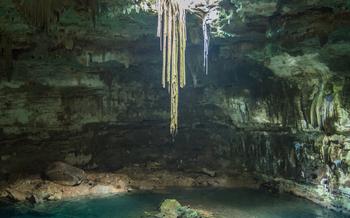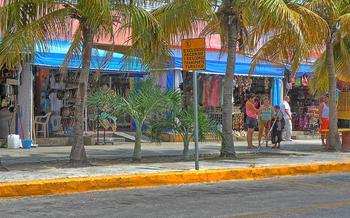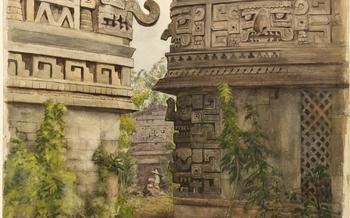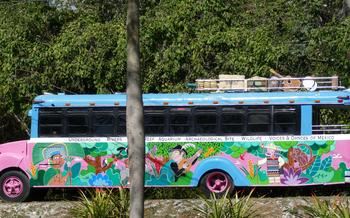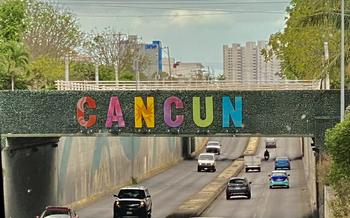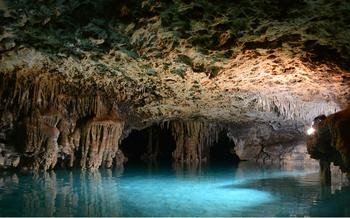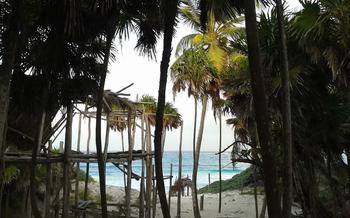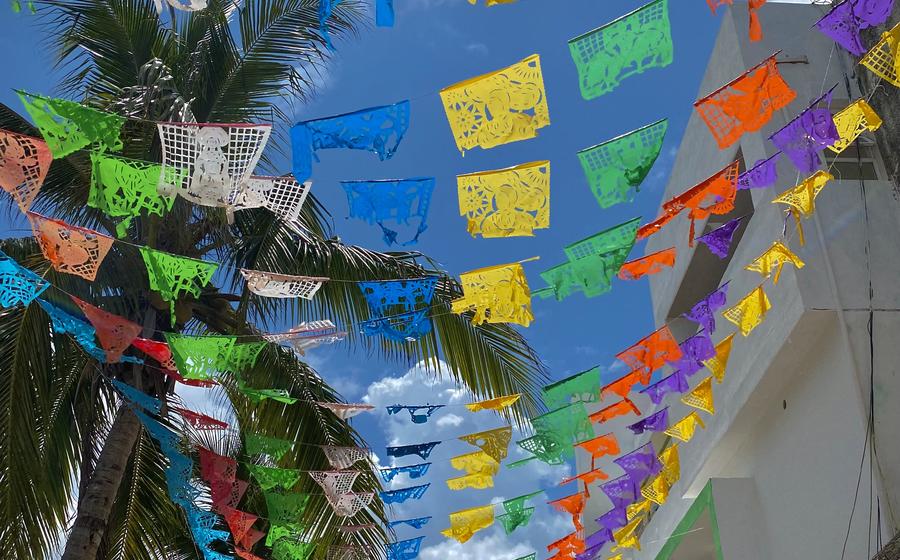
Gran Cenote (near Tulum)
- History of the Gran Cenote (Near Tulum)
- Geological Formation of the Gran Cenote: A Story of Water, Limestone, and Time
- Flora and Fauna of the Gran Cenote
- Swimming and Snorkeling in the Gran Cenote
- Visiting the Gran Cenote with Kids: Making Memories and Creating a Fun-Filled Adventure
- Photography and Videography at the Gran Cenote
- Hiking and Exploring the Surrounding Area: Discovering the Enchanting Jungle
- Picnicking and Relaxing at the Gran Cenote
- Cultural Significance of the Gran Cenote
- Conservation and Sustainability Efforts at the Gran Cenote
- Getting to the Gran Cenote: A Guide to Transportation Options
- Guided Tours and Activities
- Insider Tip: Exploring the Hidden Cenotes
History of the Gran Cenote (Near Tulum)
In the heart of the Riviera Maya, nestled amidst the lush jungles of Mexico, lies the Gran Cenote, a natural wonder that has captivated visitors for centuries. This sacred water body holds immense significance for the ancient Maya civilization, who revered cenotes as portals to the underworld and sources of life-giving water. Archaeological excavations at the Gran Cenote have unearthed a wealth of artifacts, including ceramic offerings, jade jewelry, and human remains, providing glimpses into the Maya's intricate rituals and beliefs. The cenote was believed to be a place of communication with the gods, where ceremonies and offerings were made to ensure bountiful harvests, good health, and protection from harm. Its connection to the Maya underworld, known as Xibalba, made it a site of pilgrimage and spiritual transformation.
Geological Formation of the Gran Cenote: A Story of Water, Limestone, and Time
The Gran Cenote's captivating beauty is not just a result of its crystal-clear waters and lush surroundings; it is also a testament to the intricate geological processes that shaped this natural wonder. The formation of the cenote, like many others in the Yucatán Peninsula, is a story of water, limestone, and time.
The process begins with the unique geological composition of the region. The Yucatán Peninsula is composed primarily of limestone, a sedimentary rock formed from the accumulation of marine organisms over millions of years. Limestone is highly soluble in water, making it susceptible to erosion and the formation of caves and underground rivers.
As rainwater seeps through the porous limestone, it dissolves the rock, creating cavities and channels. Over time, these cavities expand and interconnect, forming an intricate network of underground caves and rivers. When the roof of a cave collapses, it creates a cenote, exposing the hidden world beneath the surface.
In the case of the Gran Cenote, the collapse of the roof occurred relatively recently, as evidenced by the sharp and well-defined edges of the cenote walls. The cenote's proximity to the surface also suggests that the collapse may have been triggered by the weight of the overlying soil and vegetation.
The water that fills the Gran Cenote comes from both rainwater and groundwater. Rainwater seeps through the limestone and collects in the underground caves, while groundwater flows into the cenote from nearby aquifers. The constant flow of water helps to maintain the cenote's crystal-clear visibility and its vibrant blue color.
The Gran Cenote is part of a larger system of underground caves and rivers that extend throughout the Yucatán Peninsula. These caves and rivers form a complex network of interconnected water bodies, creating a unique and fragile ecosystem that supports a diverse array of aquatic life.
Flora and Fauna of the Gran Cenote
The Gran Cenote is home to a diverse array of flora and fauna, creating a vibrant and enchanting ecosystem. The lush vegetation surrounding the cenote includes towering tropical trees, ferns, orchids, and bromeliads, which provide a habitat for a variety of bird species, including parakeets, toucans, and woodpeckers. The crystal-clear waters of the cenote support a rich aquatic life, including fish such as cichlids and mollies, as well as turtles and even crocodiles. The cenote's unique environment also attracts bats, which can be seen flying overhead at dusk. The diverse flora and fauna of the Gran Cenote contribute to its ecological importance and enhance the overall visitor experience, making it a must-visit destination for nature enthusiasts and adventure seekers alike.
Swimming and Snorkeling in the Gran Cenote
The Gran Cenote is an ideal spot for swimming and snorkeling, thanks to its calm waters and crystal-clear visibility. The water temperature is a comfortable 24 degrees Celsius (75 degrees Fahrenheit) year-round, making it a refreshing and enjoyable experience.
Snorkeling in the Gran Cenote is a must-do activity for nature enthusiasts. The cenote is home to a diverse array of aquatic life, including colorful fish, turtles, and even the occasional crocodile. The underwater scenery is breathtaking, with stalactites and stalagmites creating a magical and mysterious atmosphere.
It's important to respect the cenote's fragile ecosystem while swimming and snorkeling. Avoid touching or disturbing the wildlife, and be mindful of your movements to prevent damaging the delicate underwater formations.
To make the most of your swimming and snorkeling experience, visit during the off-season (May to November) to avoid the crowds. Bring your own snorkel gear or rent it from one of the vendors at the cenote. Wear water shoes to protect your feet from sharp rocks and slippery surfaces.
Visiting the Gran Cenote with Kids: Making Memories and Creating a Fun-Filled Adventure
The Gran Cenote is a family-friendly destination that offers a variety of experiences suitable for children of all ages. The cenote's shallow areas, crystal-clear waters, and abundance of aquatic life make it an ideal place for kids to swim, snorkel, and explore the wonders of the underwater world.
In addition to swimming and snorkeling, there are opportunities for kids to learn about the cenote's history, geology, and ecosystem. Guided tours led by experienced local guides are available and provide an informative and engaging way for children to discover the cenote's unique features.
To make the most of the visit with kids, it is recommended to bring snacks and water, as well as towels, sunscreen, and hats to protect from the sun. Life jackets and other safety measures are available for children, ensuring a safe and enjoyable experience for the whole family.
The Gran Cenote is a great place for kids to learn about the natural world, have fun, and create lasting memories. Whether it's swimming, snorkeling, exploring, or simply relaxing in the tranquil atmosphere, the cenote offers a range of activities that will delight and entertain children of all ages.
Photography and Videography at the Gran Cenote
The Gran Cenote offers a stunning backdrop for photography and videography enthusiasts, with its beautiful scenery and unique features. The crystal-clear waters, lush vegetation, and impressive rock formations provide ample opportunities to capture breathtaking shots. Here are some tips for capturing the best photos and videos at the Gran Cenote:
Use a waterproof camera and tripod: The cenote's waters are crystal-clear, but it's still a good idea to use a waterproof camera to protect your equipment from splashes and accidental drops. A tripod will help you stabilize your camera and capture sharp, blur-free shots.
Experiment with different angles and lighting conditions: The Gran Cenote offers a variety of interesting angles and lighting conditions throughout the day. Try shooting from different vantage points, such as from the edge of the cenote, from the water, or from the jungle canopy. Experiment with different lighting conditions, such as the soft light of dawn and dusk, or the harsh light of midday.
Respect the environment: While taking photos and videos, it's important to respect the cenote's fragile environment. Avoid disturbing the wildlife, and be mindful of other visitors.
Share your cenote experiences: Once you've captured your stunning photos and videos, don't forget to share them with others! Post them on social media, or create a travel blog to share your cenote experiences with the world.
Hiking and Exploring the Surrounding Area: Discovering the Enchanting Jungle
Beyond the refreshing waters of the Gran Cenote, a verdant world awaits exploration. A network of trails meanders through the lush jungle surrounding the cenote, inviting adventurers to immerse themselves in the beauty of the natural surroundings. Hiking these trails offers a chance to connect with nature and encounter the diverse wildlife that calls this ecosystem home. From playful monkeys swinging through the trees to colorful iguanas basking in the sun, the jungle is teeming with life.
As you tread along the winding paths, keep an eye out for exotic birds flitting through the foliage. The melodious songs of tropical birds fill the air, creating a symphony of sound that enhances the tranquility of the jungle. The trails also lead to other hidden gems, such as secluded cenotes, ancient Maya ruins, and local villages. These nearby attractions provide an opportunity to delve deeper into the region's rich history and culture.
While exploring the jungle, remember to stay on designated trails to minimize your impact on the environment. Respect the natural surroundings by refraining from disturbing the wildlife and leaving no trace of your presence. By following these guidelines, you can contribute to the preservation of this delicate ecosystem while enjoying the wonders of the jungle.
Picnicking and Relaxing at the Gran Cenote
After a refreshing swim or an exhilarating dive, take a break and enjoy a leisurely picnic surrounded by the tranquil beauty of the jungle. Designated picnic areas offer a perfect spot to spread out your blanket, unpack your delicious homemade lunch, and savor the flavors of the region. Choose from a variety of local specialties, such as fresh ceviche, flavorful tacos, and tropical fruits, to create a feast that will tantalize your taste buds.
As you savor your meal, let the gentle breeze rustle through the leaves and the soothing sounds of nature lull you into a state of relaxation. Take a moment to appreciate the stunning scenery that surrounds you, from the crystal-clear waters of the cenote to the lush greenery of the jungle. Disconnect from the digital world and reconnect with nature, allowing the tranquility of the environment to wash away your worries.
For those who prefer not to pack a picnic, several restaurants and cafes are located nearby, offering a variety of dining options to suit every taste and budget. Indulge in local delicacies or international cuisine, all while enjoying the unique ambiance of the jungle setting. Remember to bring reusable containers and utensils to minimize waste and contribute to the sustainability efforts of the cenote.
Cultural Significance of the Gran Cenote
The Gran Cenote holds immense cultural significance for the Maya, both historically and contemporarily. In ancient times, it was revered as a sacred site, a place of spiritual connection and communion with the divine. The Maya believed that cenotes were portals to the underworld, Xibalba, where the gods resided and where the souls of the deceased journeyed after death. The cenote's crystal-clear waters were considered sacred and were used for religious ceremonies and rituals, including offerings and sacrifices to appease the gods.
Today, the Gran Cenote remains a place of cultural importance for the local Mayan community. Many Maya still visit the cenote to pray, make offerings, and seek spiritual guidance. The cenote is also a popular destination for cultural tours, providing visitors with an opportunity to learn about Maya culture, traditions, and beliefs. By visiting the Gran Cenote, travelers can gain a deeper understanding of the rich cultural heritage of the Maya people and their enduring connection to this sacred site.
Conservation and Sustainability Efforts at the Gran Cenote
The Gran Cenote is a natural wonder that requires careful conservation to ensure its long-term sustainability. Several measures have been implemented to protect the cenote's fragile ecosystem, including eco-friendly practices like waste management and water conservation. Visitors are encouraged to follow the cenote's rules and regulations, such as limiting the use of sunscreen and avoiding disturbing the wildlife. By choosing responsible tour operators and making sustainable choices, visitors can contribute to the conservation efforts and help preserve the cenote for future generations.
Getting to the Gran Cenote: A Guide to Transportation Options
Reaching the Gran Cenote from Playa del Carmen and Beyond
The Gran Cenote is conveniently located just a short distance from Playa del Carmen, making it an accessible destination for travelers staying in this popular tourist hub. The cenote is approximately 25 kilometers (15 miles) south of Playa del Carmen, and the journey takes about 30 minutes by car. Several transportation options are available for visitors who wish to visit the cenote, including rental cars, taxis, and organized tours.
Renting a Car: Flexibility and Independence
For those who prefer the freedom and flexibility of exploring at their own pace, renting a car is an excellent option. Several car rental agencies are located in Playa del Carmen, and the cost of renting a car typically ranges from $30 to $50 per day. Once you have rented a car, simply follow the signs to Tulum and then look for the signs for the Gran Cenote.
Taking a Taxi: Convenience and Comfort
If you prefer not to drive yourself, taking a taxi is a convenient and comfortable way to reach the Gran Cenote. Taxis are readily available in Playa del Carmen, and the fare to the cenote typically costs around $20 to $2Taxis can be hailed on the street or booked in advance through a local taxi company.
Joining an Organized Tour: The Hassle-Free Option
For those who prefer a hassle-free experience, joining an organized tour is a great option. Many tour operators in Playa del Carmen offer day trips to the Gran Cenote, which typically include transportation, a guided tour of the cenote, and snorkeling equipment. The cost of organized tours varies depending on the operator and the inclusions, but typically ranges from $50 to $75 per person.
Parking at the Gran Cenote: Ample Space and Reasonable Rates
The Gran Cenote has ample parking space available for visitors, and the parking fee is a reasonable $5 per car. The parking lot is located near the cenote entrance, making it easy for visitors to access the cenote after parking their vehicles.
Choosing the Best Option: Consider Your Needs and Budget
The best transportation option for reaching the Gran Cenote depends on your individual needs and budget. If you prefer the flexibility and independence of exploring at your own pace, renting a car is a good choice. For those who prefer a more convenient and hassle-free experience, joining an organized tour is a great option. And for those who want to save money, taking a taxi is a viable alternative.
Guided Tours and Activities
The Gran Cenote offers a wide range of guided tours that cater to different interests and preferences. For those seeking a deeper understanding of the cenote's history, geology, and ecosystem, guided cultural tours are available. These tours are led by experienced local guides who share their knowledge and insights about the cenote and its significance to the Maya and the local community. Snorkeling and diving tours are also available, providing an opportunity to explore the cenote's vibrant underwater world under the guidance of certified instructors. For a truly personalized experience, private tours can be arranged, allowing visitors to customize their itinerary and receive undivided attention from their guide. Whether you're a history buff, nature enthusiast, or adrenaline seeker, there's a guided tour at the Gran Cenote that's perfect for you.
Insider Tip: Exploring the Hidden Cenotes
Beyond the popular Gran Cenote, the surrounding area is dotted with a multitude of hidden cenotes, each offering its own unique charm and tranquility. These lesser-known gems provide an opportunity to escape the crowds and immerse yourself in the pristine beauty of the Yucatan Peninsula's natural wonders.
One such hidden cenote is Cenote Calavera, located just a short walk from the Gran Cenote. True to its name, which means "skull cenote" in Spanish, Cenote Calavera features an eerie yet fascinating skull-shaped opening. As you descend into the cenote, you'll be greeted by crystal-clear waters and dramatic rock formations that create a mystical ambiance.
Another hidden gem is Cenote Cristalino, renowned for its breathtakingly clear waters that offer exceptional visibility. This cenote is perfect for snorkeling and diving enthusiasts, allowing you to observe the diverse aquatic life up close. The surrounding lush vegetation and vibrant underwater world create a mesmerizing spectacle that will leave you in awe.
To discover these hidden cenotes, it's best to venture off the beaten path and explore the surrounding jungle trails. Be prepared for a bit of adventure, as some of these cenotes may require a short hike or a swim through narrow passages. However, the reward is well worth the effort, as you'll be greeted by secluded oases that offer a tranquil escape from the tourist crowds.
When exploring hidden cenotes, it's essential to exercise caution and respect the natural environment. These cenotes may not have the same safety features and facilities as the Gran Cenote, so it's important to be self-sufficient and aware of your surroundings. Bring appropriate gear, such as a flashlight and sturdy shoes, and always let someone know your intended route and expected return time.
With a sense of adventure and respect for the environment, exploring the hidden cenotes near the Gran Cenote is an unforgettable experience that will reward you with breathtaking natural beauty and a deeper connection to the wonders of the Yucatan Peninsula.
